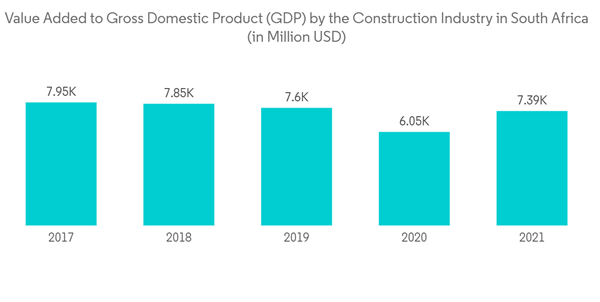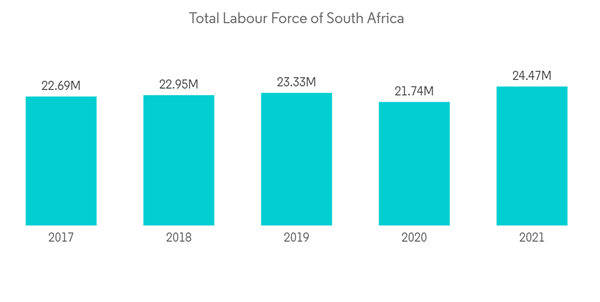Key Highlights
- South Africa's prefabricated buildings industry is expected to grow at a CAGR of more than 5% during the forecast period. One of the major factors driving the growth of the prefabricated buildings market is the increasing demand for building construction in South Africa. The implementation of building information modeling (BIM) is projected to act as an opportunity for the prefabricated buildings market in the future. On the flip side, technical issues associated with prefabrication, such as weak joints and poor thermal insulation performance, are expected to hinder the market growth.
- The industry's growth over the forecast period will be supported by government investments in transport, energy, residential, telecommunication, and industrial projects. Support from the government for businesses and Small and Medium Enterprises (SMEs) is expected to boost business confidence.
- The demand for hospitals and patient bed facilities based on prefabricated construction has significantly increased during the peak of the pandemic as this type of construction needs a very less amount of completion time. The high cost of logistics involved in prefabricated building construction is expected to hinder the growth of the market.
South Africa Prefabricated Buildings Market Trends
Government Initiatives Helping the Construction Industry
The construction industry's output has been severely affected by the COVID-19 pandemic. To help the economy recover from the crisis, in June 2020, the government announced a 10-year infrastructure investment plan worth 124.7 billion USD to invest in housing, energy, agriculture, transportation, and water, health facilities, and the digital infrastructure sector. The construction industry witnessed a slow but steady recovery in 2021 with Afrimat's construction index increasing by 2.8% in the third quarter of 2021.Officials from the World Bank, African Development Bank (AfDB), and South African Development Bank (DBSA) have pledged to support infrastructure construction and are expected to create more than 1.8 million jobs in the next 10 years.
In another positive development, in October 2020, the government launched an ambitious 60 billion USD economic reconstruction and recovery plan, which has four priority interventions: basic investment in facilities, expanding energy production capacity, creating jobs to support livelihoods, and industrial growth. In October 2021, South Africa's president Cyril Ramaphosa announced plans to designate the Sedibeng area as an SEZ, with the SEZ expected to attract 99 investment opportunities worth USD 3 billion. The government's plans to expand the number of Special Economic Zones (SEZ) throughout the country will also help the industry grow.
Impact on Labour Force in South Africa
In South Africa, the labor market has been severely affected by COVID-19. Except for essential services and emergency repairs and maintenance related to the health sector, all work on the construction site was suspended.Global mass production closures, supply chain disruptions directly impacted Africa’s access to industrial parts and manufactured goods. The construction industry has also suffered a considerable blow, as the Association of Builders reported that they are facing cash flow challenges due to construction shutdowns.
Many companies faced obstacles like contractual obligations, resource availability, deliverables, health and safety measures, and project delays or cancellations. Due to these conditions labor force decreased drastically. Many migrant workers left the country and went to their home country. Many construction projects delayed due to the shortage of labor force in the country.
South Africa Prefabricated Buildings Market Competitor Analysis
The market is relatively fragmented as there are several international as well as domestic companies present in South Africa's prefabricated buildings market. Companies are implementing effective production technologies to minimize product costs and reduce related risks. High capital requirements and rapid technological advancement are important barriers to entry for new participants.Some suppliers are providing fully customized wooden prefabricated structures. The market is expected to grow during the forecast period due to the increase in the prefab construction building investments and upcoming major projects in the country and other factors that are driving the market. Major players are Karmod Prefabricated Building Technologies, Kwikspace Modular Buildings Ltd., Cube Modular, Fabricated Steel Manufacturing, and Concretex.
Additional Benefits:
- The market estimate (ME) sheet in Excel format
- 3 months of analyst support
Table of Contents
1 INTRODUCTION1.1 Study Assumptions
1.2 Scope of the Study
2 RESEARCH METHODOLOGY
2.1 Analysis Methodology
2.2 Research Phases
3 EXECUTIVE SUMMARY
4 MARKET INSIGHTS AND DYNAMICS
4.1 Current Market Scenario
4.2 Technological Trends
4.3 Insights on Supply Chain/Value Chain Analysis of the Prefabricated Buildings Industry
4.4 Brief on Different Structures Used in the Prefabricated Buildings Industry
4.5 Cost Structure Analysis of the Prefabricated Buildings Industry
4.6 Impact of COVID-19 on the Market
4.7 Insights on Different Types of Materials used in Prefabricated Buildings Construction
5 MARKET DYNAMICS
5.1 Drivers
5.2 Restraints
5.3 Opportunities
5.4 Industry Attractiveness- Porter's Five Forces Analysis
5.4.1 Bargaining Power of Suppliers
5.4.2 Bargaining Power of Consumers/Buyers
5.4.3 Threat of New Entrants
5.4.4 Threat of Substitute Products
5.4.5 Intensity of Competitive Rivalry
6 MARKET SEGMENTATION
6.1 By Material Type
6.1.1 Concrete
6.1.2 Glass
6.1.3 Metal
6.1.4 Timber
6.1.5 Other Material Types
6.2 By Application
6.2.1 Residential
6.2.2 Commercial
6.2.3 Industrial
7 COMPETITIVE LANDSCAPE
7.1 Overview
7.2 Company Profiles
7.2.1 Karmod Prefabricated Building Technologies
7.2.2 Kwikspace Modular Buildings Ltd.
7.2.3 Cube Modular
7.2.4 Fabricated Steel Manufacturing
7.2.5 Concretex
7.2.6 Panelman Engineering
7.2.7 Fluor
7.2.8 Nyumba
7.2.9 M Projects
7.2.10 Homescor*
8 MARKET OPPORTUNITIES AND FUTURE TRENDS
9 APPENDIX
9.1 Marcroeconomic Indicators (GDP breakdown by sector, Contribution of construction to economy, etc.)
9.2 Key Production, Consumption,Exports & import statistics of construction Materials
Companies Mentioned (Partial List)
A selection of companies mentioned in this report includes, but is not limited to:
- Karmod Prefabricated Building Technologies
- Kwikspace Modular Buildings Ltd.
- Cube Modular
- Fabricated Steel Manufacturing
- Concretex
- Panelman Engineering
- Fluor
- Nyumba
- M Projects
- Homescor
Methodology

LOADING...










